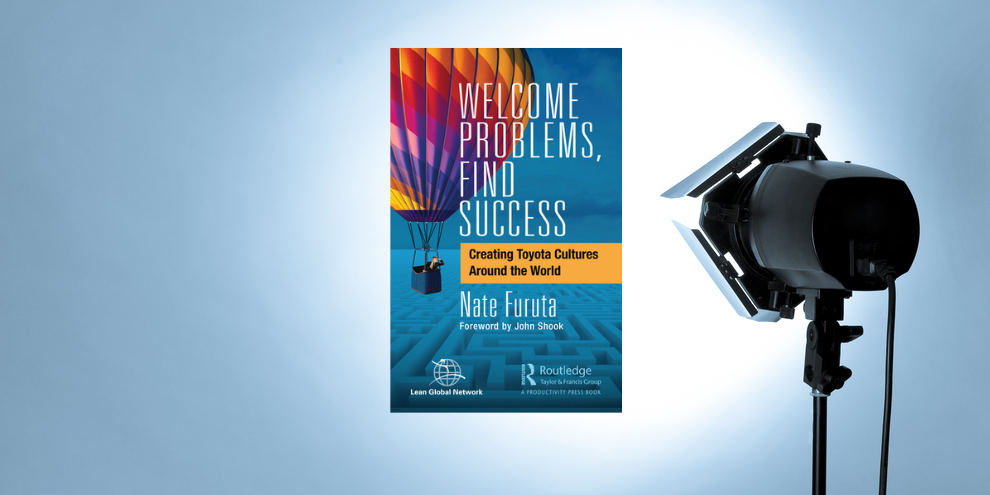
A chat with Furuta-san
INTERVIEW – PL meets the author of the recently published book Welcome Problems, Find Success, who discusses bringing lean to different cultures and changing managerial behaviors.
Interviewee: Kiyoshi “Nate” Furuta, lean author
Planet Lean: You have worked with many leaders from several countries. What lessons can you share about developing leaders to understand “lean” or the Toyota Way in different cultures?
Kiyoshi “Nate” Furuta: Before answering this question, I think it’s important to remember what the Toyota Way is: an organizational or team effort to relentlessly pursue improvement of corporate performance through the identification of problems and the creation of challenges at all levels. This type of corporate culture is not Japanese, per se. It’s purely logical, which means that management in any culture can master it so long as it is “codified” properly.
At the beginning, Toyota’s approach to leadership development was based on the appointment of a Japanese coordinator or advisor/teacher asked to support the local team on site at each global location. However, we found that trainers and coordinators too had different ways of interpreting and understanding the Toyota Way and that they developed their local managers accordingly. As a result, we saw the gap from the true Toyota Way widen.
Therefore, to ensure people truly understood the Toyota culture that we wanted them to embrace, we requested extensive documentation from HQ (on corporate vision, mission, and what’s expected of management), studied it, and used it to craft our own local culture. Essentially, we documented and clarified what was expected of leaders in written documents – which is really the reason Mr. Cho compiled the Toyota Way in 2001.
PL: What were your key learnings with regards to enabling managers to both understand Toyota’s culture and change their behaviors?
KNF: I found the appraisal system to be a tool that could be used for this. If you set expectations for managers without assessing their behaviors and giving direct feedback, no one will change their behavior. Another important tool was, of course, education. For example, we made problem-solving training mandatory for anyone at team leader level and above. In Europe, I made successfully undertaking problem solving training the final milestone before a candidate could be promoted to Vice President level. We saw candidates work very very hard with their bosses – the presidents of local operations – to tackle complex challenges and prepare their A3 problem-solving reports. Presidents trained the to-be VPs very hard (the presidents were the ones who recommended the candidates for promotion, after all) and candidates, of course, made a huge effort to leverage the power of problem solving. This is how top managers at European operations became the main drivers of the problem-solving culture permeating Toyota.
At the very beginning of the Georgetown operation, we found that managers had a tendency to jump to conclusions without proper fact-finding, to show their bosses how capable they were. We introduced the A3 problem solving format as a standard way for managers to make proposals (after providing them with the relevant training). If they did not follow the logical flow of A3, we wouldn’t accept the proposal at all.
After coming back to the USA from Europe, I created the Team Member Development Center to further instill problem solving further in our management thinking. We defined competency requirements for appraisal and problem solving for management as Toyota Business Practice. I taught managers across our manufacturing operations in North America to help them to realize what they could do with problem solving. TBP reports became a critical step for managers to take if they wanted to be promoted to executive positions.
PL: What behaviors and thinking were especially important and perhaps difficult for managers to change?
KNT: I would say there are two: one was admitting problems, the other teamwork. No one likes to admit there is a problem, but that is the starting point of any problem-solving activity as well as the base of a lean culture. To survive in a very competitive environment, managers often blamed someone else for problems or directly pretended there was no problem to speak of. This behavior is dangerous and had to be eliminated. This is why the first domain of one of the two categories of our global appraisal system, Competency Appraisal (the other is Performance Appraisal), is the identification of critical issues. In turn, this domain is divided into two dimensions: “accurate information gathering and analysis” and “creation of innovative vision”. This is basically a way to gauge whether managers can see the information accurately – a pre-condition to the resolution of any problem – and create the vision to overcome those challenges.
Traditionally, managers like clear roles and responsibilities and don’t worry about what’s outside their immediate remit. At Toyota, this doesn’t happen, because there will always be unexpected situations where no one is responsible but action has to be initiated nonetheless to fix the problem at hand. There is an expectation at Toyota that, with the support of their teams and thanks to hoshin activities, managers will tackle problems as they appear. We asked manager to clarify which company departments must be involved in order to carry out their Hoshin activities and get support from those departments. So, a manager must create a broad-based, often cross-functional team to accomplish their challenge.
PL: Are there any differences in basic management thinking between Japanese leaders and those in North America or Europe?
KNF: I don’t think there are significant management differences between Japan and Western cultures; just between good companies and not-so-good companies! There might be a tendency for Japanese managers to be quite team-oriented and focused on people development, but the same is true for Western companies that we can describe as “high performers”.
PL: Did you utilize methods or processes from Toyota Japan in developing leaders and managers? What, if anything, did you adapt to local circumstances?
KNF: In addition to the appraisal system that I mentioned earlier, we relied on hoshin kanri to help leaders to develop their vision and targets in alignment with the company’s. This enables us to sync tasks being carried at each level of the organization with the strategy devised by top management. Before we could apply hoshin outside of Japan, I had to ask Headquarters to provide an explanation in English of the strategy deployment approach in use at Toyota. When we got the booklet, I reviewed it and trained European managers using it, but I don’t remember any significant changes to adapt to local circumstances.
PL: NUMMI employed a union workforce. Did that present unique problems or opportunities? Georgetown’s workforce was not unionized. What was different in managing labor-management relations between the two?
KNF: In Japan, Toyota’s workforce is unionized throughout the company, so this wasn’t a new situation for us. However, it is true that American Unions are structured differently and represent workers in the industry – not just in an individual company. This created difficulties, because the international union had the power to reject local conditions even when the local union had agreed to them. We also found that shop committees are easily influenced by the politics inherent to an international union, which often generates conflict among different caucuses and gave us a few headaches. Having said that, NUMMI workers trusted the company and developed the best labor relations among unionized plants – as recognized by the ILO (International Labor Organization) itself.
Georgetown’s workforce is not unionized at all, but I still asked HR representatives to represent workers, speak up for them when they had any grievances, and protect them from unfair treatment from a manager. We had, for example, a peer-review system in place for termination cases and stripped managers of the power to terminate, promote or discipline a team member without HR approval. We also conducted an annual survey to gather feedback and implemented a hotline to listen to any opinion coming from the production floor. In many ways, it was like having union representatives on site (I believe it’s important to treat our employees better than a unionized plant would). Our workers responded very positively to this support coming from HR and developed trust in the company as a good place to work.
Mr. Cho often referred to the time a very heavy snow day threatened to halt production as we expected fewer workers to be able to come to work. But then the workers from the second shift offered to work overtime, while most first-shift workers managed to show up on time after commuting early and even staying at a nearby hotel. If this isn’t a sign of the mutual trust that had developed between management and employees, I don’t know what is!
PL: HR is rarely used as a driver for a lean transformation. Why do you think that is? And why is the role of HR so important when trying to bring change about?
KNF: For a lean system to take hold, we need team members across the organization to trust management. If they don’t – perhaps because they fear that job losses will result from productivity improvements – teams won’t participate in kaizen efforts. In the same way, why would a local manager whose effort to tackle a challenge is not recognized bother making the effort or running a risk?
HR has a key role to play in the development of an environment characterized by mutual trust. They are responsible for employee relations, organizational development, and training and education as well as the financial security of employees (for example, benefit management). HR is also responsible for designing and administering monetary rewards, from salaries to incentives in line with the appraisal systems in place. Indeed, if they play their cards right – treating people with respect, rewarding them when appropriate and listening to their problems – the HR function can create a great working environment. What would have happened at NUMMI if we hadn’t leveraged our “Toyota ethos” to agree with UAW on a solid labor contract? Labor relations might as well have destroyed the company (in contrast, look at what happened to Saturn or Mazda in Flat Rock, where mistrust between labor and management was widely cited as the reason for failure of a lean culture to take root).
Let’s not forget that HR is the only department in an organization that can defend employees from unfair treatment by managers and other functions. Finance protects money, Engineering protects technique and design, Manufacturing protects product, IT protects information, and HR protects people so that they can embrace a kaizen mindset. I urge any company on a lean journey to assess its HR function to ensure they can create employee trust.
PL: The importance of having great teachers can’t be stressed enough. In your book, you mention two: Kenzo Tamai and Iwao Isomura. In what ways did their approaches to problem-finding differ?
KFN: Both were tremendous problem solvers and teachers, but Isomura-san had a bird’s eye view while Tamai-san had a “worm’s view”. Isomura-san could turn complicated problems into simple ones by breaking them down, whereas Tamai-san was great at finding facts and analyzing them to truly understand the problem at hand. Isomura was quick to take action while Tamai was prudent and patient to make sure problems were solved at the root cause and systemic levels.
PL: Over the course of your career, you worked on both greenfield and brownfield projects. What were the difficulties inherent to each of the two scenarios?
KNF: They present different issues. Both call for a ton of work: in greenfield projects, this is to build the process from scratch, in brownfields to “clean the slate” and change behavior and bad habits. I personally like greenfield because I get to design what I believe to be ideal. This is what I did at Georgetown, where I selected, developed, and promoted the workforce based on their potential and ability to embrace the Toyota Way. Today, they are the ones spreading the Toyota culture and kaizen spirit across our plants in North America.
Read about Nate Furuta's outstanding experience exporting Toyota cultures to environments as diverse as NUMMI and the company's European operations.




THE INTERVIEWEE
Nate Furuta is author of Welcome Problems, Find Success - Creating Toyota Cultures Around the World. He has 38 years of experience working for Toyota, helping the organization establish some of its most challenging ventures around the world.
Read more


WOMACK’S YOKOTEN – In his first column of 2018, the author looks at one of the most talked about companies in the world, Tesla, from a lean point of view.


1 QUESTION, 5 ANSWERS – Lean management causes a huge shift in the mind of leaders, one that dramatically changes the way they think of themselves and the way they behave. We asked five leaders to tell us how lean changed them.


FEATURE - Presenting the key concepts in her latest book, the author tells us how to escape the feature frenzy trap and build products customers love.


FEATURE – In this call to arms, the author encourages us to fight to prove the relevance of Lean Thinking in such difficult times and explains why only mastering it can truly address our problems.

